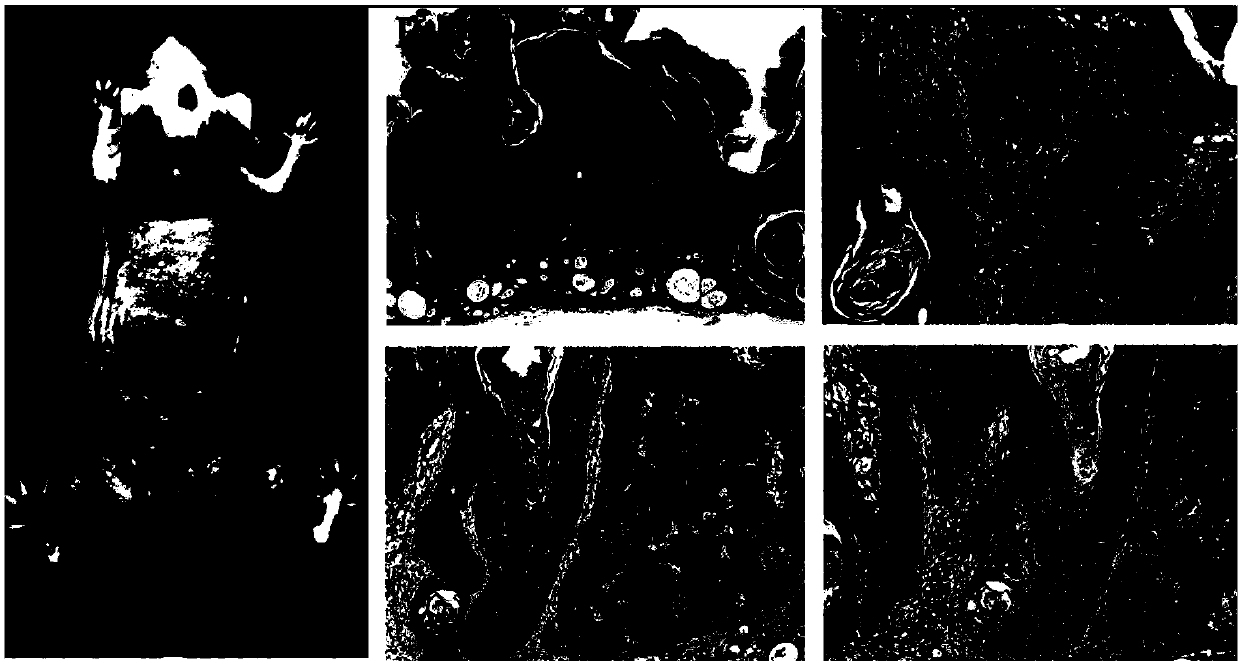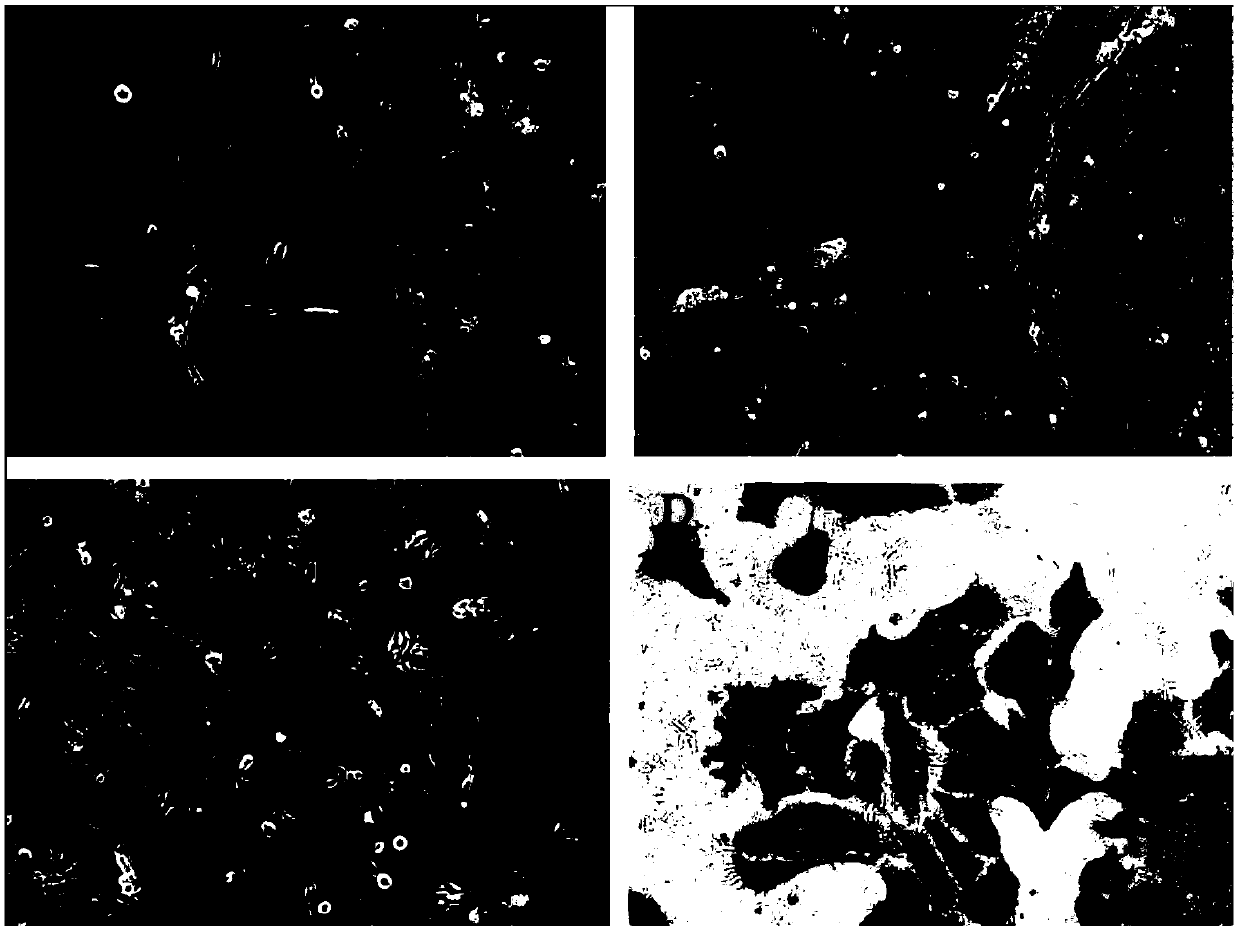SKH-1 mouse skin squamous carcinoma cell line and application thereof in preparation of transplanted tumor model
A technology of SKH-1 and cancer cells, applied in the direction of tumor/cancer cells, animal cells, vertebrate cells, etc., can solve the problems of limited application, achieve good growth, fast proliferation, and make up for the effect of long modeling cycle
- Summary
- Abstract
- Description
- Claims
- Application Information
AI Technical Summary
Problems solved by technology
Method used
Image
Examples
Embodiment 1
[0087] Establishment of UV-induced mouse SCC model.
[0088] Ten female SKH-1 hairless mice aged 6-8 weeks were selected, and the back skin of the mice was irradiated with a solar ultraviolet simulator close to the solar spectrum to construct a mouse skin scale model. The irradiation distance of the solar ultraviolet simulator is 30cm, and the actual output power irradiated to the mouse skin is UVB 3.0mW / cm 2 , UVA 27mW / cm 2 , the irradiation dose is the minimum erythema dose MED, 5 days a week of continuous irradiation, and after 18 weeks of continuous irradiation, new organisms > 1 mm and accompanied by ulceration can appear on the back of the mouse. The new organisms were excised by trepanning, soaked in formalin and fixed for pathological diagnosis.
[0089]24 to 48 hours after the first irradiation of the mice, erythema and fine debris appeared on the back, occasionally accompanied by slight edema. Continue to illuminate, the above skin reaction will gradually increase...
Embodiment 2
[0093] Primary culture of mouse SCC cell line.
[0094] SCC tumor-bearing mice 28 weeks after UV induction were sacrificed by cervical dislocation. Put the mouse into a dressing bowl filled with 75% alcohol and soak it for 10 minutes, cut out the tumor mass of the UV-induced SCC tumor-bearing mouse, remove the scab and necrotic tissue on the surface of the tumor, and use 2% double antibody ( 200U / ml penicillin and 200μg / ml streptomycin) were washed with PBS three times to remove the blood stains; the cleaned tumor was placed in a dressing bowl filled with high-glucose DMEM medium, and the connective tissue was cut off with ophthalmic scissors and submucosal blood vessels, cut the tumor into minced meat, about 2mm 3 Size, collected in PBS 15ml centrifuge tube containing 1% double antibody, 1000rpm / min, 5min, centrifuged and washed 3 times until the liquid was clear; discard the supernatant, add 0.25% trypsin equal to the volume of the tumor tissue block according to the size o...
Embodiment 3
[0097] Purification and passage of freshly isolated cell lines.
[0098] Fibroblasts were removed by enzymatic digestion combined with differential attachment method, and SCC cells were purified; when the cells reached 80% to 90% confluence, the cells were digested with 0.25% trypsin-EDTA trypsin and DMEM complete medium with 10% FBS After the digestion was terminated, the cells were collected by centrifugation and seeded to 25 cm 2 Inoculated culture flasks with a cell density of 3×10 5 / ml. The culture medium of SCC cells within 5 passages is DMEM medium containing 20% FBS, 2% double antibodies (200U / ml penicillin and 200μg / ml streptomycin) and 10ug / ml amphotericin B, 1:2 passaging , subcultured approximately every 3 days. After the 5th generation, the culture medium of SCC cells was replaced with DMEM culture medium of 10% FBS, 1% double antibody (100 U / ml penicillin and 100 μg / ml streptomycin) and 10 ug / ml amphotericin B, and passaged according to 1:3. After 10 gener...
PUM
| Property | Measurement | Unit |
|---|---|---|
| diameter | aaaaa | aaaaa |
| thickness | aaaaa | aaaaa |
Abstract
Description
Claims
Application Information
 Login to View More
Login to View More - R&D
- Intellectual Property
- Life Sciences
- Materials
- Tech Scout
- Unparalleled Data Quality
- Higher Quality Content
- 60% Fewer Hallucinations
Browse by: Latest US Patents, China's latest patents, Technical Efficacy Thesaurus, Application Domain, Technology Topic, Popular Technical Reports.
© 2025 PatSnap. All rights reserved.Legal|Privacy policy|Modern Slavery Act Transparency Statement|Sitemap|About US| Contact US: help@patsnap.com



